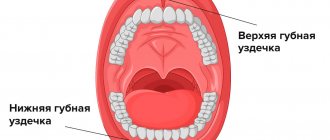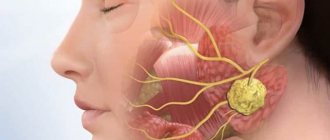In our clinic, plastic surgery of the frenulum of the tongue and lip is performed by highly qualified pediatric dental surgeons. Anesthesia is performed step by step, both local using an application gel followed by the injection of an anesthetic, and under general anesthesia - mask anesthesia.
Frenumplasty is a simple and effective operation with virtually no complications. After the operation, the child feels well and pain is minimal.
The hyoid frenulum is an elastic membrane that connects the tongue to the oral cavity. Thanks to its presence, we are able to control the mobility of the tongue, regulate breathing, speech, and eat food. This strip of tissue normally originates from the inner middle of the tongue, continuing along the mucosa and ending near the base of the gums of the central incisors of the lower jaw. It is approximately 3 cm long.
Ankyloglossia or shortened frenulum of the tongue is a diagnosis that parents of children can often hear from pediatric dentists. What is this pathological condition? The upper end of the frenulum in this case is not located in the middle, but at the tip of the tongue or a little closer.
By lifting the tip of the tongue, you can see it in the form of a groove, which often bifurcates. If you stick your tongue out, its tip bends down and slightly covers the lower lip. This fold fixes the tongue in the wrong position, which limits its mobility. This type of bridle is called short. As a result of such a defect, the development of the lower jaw may be delayed, general discomfort may arise, and malocclusion and speech disorders may develop.
Causes of the defect
The anomaly occurs during intrauterine development. The provoking factors of a short frenulum of the tongue are:
- fetal infection;
- viral diseases that occur during the first and last trimester of pregnancy;
- genetic predisposition, heredity;
- unfavorable environmental background;
- abdominal injuries of a pregnant woman;
- chronic somatic diseases of the expectant mother.
The decisive factor is heredity. It was noted that among parents who personally encountered a similar pathology, their children often also needed frenulum correction.
The main signs of a short frenulum
The following may indicate that your child has developed an abnormal frenulum:
- heart-shaped tongue, especially noticeable in an elevated position;
- difficulty stretching the tongue;
- bending of the tongue down when protruding it;
- difficulty swallowing;
- digestive problems, bloating and colic;
- Difficulty in pronouncing certain sounds.
Diagnostic methods
How can a tongue tie be diagnosed in infants? Parents can easily recognize this defect on their own. The baby’s tongue is tightly attached to the lower jaw, its movements are limited (mobility directly depends on the severity of the anomaly), the child is not able to stick his tongue out of his mouth. By lifting the baby's tongue, you can see the connective tissue thread that attaches the tongue to the oral cavity.
This diagnosis can be easily recognized during breastfeeding. For such babies, the feeding process takes a longer time, since the baby is not able to grasp the nipple normally. Therefore, the sucking process is difficult and intermittent. Because of this, these babies gain weight slowly and become restless before feeding.
In older children, such a pathology as a short frenulum is expressed by a violation of word formation and a lisp - it is difficult for them to pronounce the sounds sh, shch, h, zh, r.
Degrees of anomaly
In pediatrics, there are several degrees of pathology of the frenulum under the baby’s tongue:
| Degree | Symptoms |
| I | Thinning of the frenulum up to a translucent state and its shortening, which prevents the normal mobility of the tongue. |
| II | A frenulum with a defect is attached close to the end of the tongue, causing it to resemble a heart when raised. |
| III | The short, thickened section of the frenulum is also located close to the edge, which is why the tongue bends in a slide when lifted. |
| IV | A massive cord penetrates the muscular structure of the tongue, which usually occurs in parallel with a cleft lip or palate. |
| V | The dense area of the frenulum almost does not appear against the background of the tongue and fuses with the muscles, severely limiting the latter’s ability to move (the so-called ingrained tongue) |
Thus, the danger of pathology increases depending on the degree of limitation of tongue mobility.
Treatment of a short frenulum of the tongue
In children, treatment of a short frenulum is carried out surgically. Excision of the frenulum is a simple operation with virtually no complications. After this procedure, the child feels well and does not experience any pain.
The decision on the need to trim the frenulum (frenotomy) is made immediately as soon as the baby is born, since bloodless plastic surgery cannot affect the general condition of the newborn. The procedure can be performed directly in the maternity hospital or in the dental office. Babies have few blood vessels and nerve endings, so the doctor does not use anesthesia when making a transverse incision. If there is slight bleeding, it can be easily stopped by applying the baby to the chest. After the operation, the newborn adapts to the new conditions for several days, so the mother will immediately feel the difference during feeding.
If the short frenulum is not corrected in time, the child may develop other developmental pathologies a few years later, such as incorrect dentition, speech defects, etc. If you ignore plastic surgery until the child is 5-6 years old, there may be a need for real surgical intervention, in which Sutures are placed and anesthesia is administered. Trimming the frenulum is carried out with special scissors or a radio wave scalpel. The duration of the procedure is no more than a minute.
Children of primary school age are brought to the surgical office by an orthodontist or speech therapist when the consequences of an untreated short frenulum are too obvious. During the operation, the tongue is released. Separately, uneven teeth and incorrect pronunciation have to be corrected.
In the event that it was not possible to perform plastic surgery in childhood, and a short frenulum of the tongue as a person grows older causes severe discomfort and significantly limits the excursion of the tongue, it is necessary to visit a dentist. The doctor will recommend an operation that can relieve the patient of speech defects and periodontal inflammation in the area of the lower incisors. In both adult patients and adolescents, the operation is performed under general anesthesia, using self-absorbing sutures.
Treatment options
If the clinical indications for surgery are painful attachment to the breast and small weight gains, in infants the frenulum is dissected in its center. This simple operation is called frenotomy. How does it go? The parent holds the baby's head, the doctor lifts and fixes the tongue, and then begins the operation itself. A big advantage of frenotomy is that there is no need for anesthesia or sutures. After cutting the hyoid frenulum, the baby can be immediately applied to the breast.
Z-plasty is a more complex operation that requires local anesthesia and suturing. The choice of pain relief method depends on the child’s physical health, his age and emotional state. General anesthesia is usually used when working with children under 5 years of age with a labile psyche.
Frenuloplasty
Frenuloplasty is a surgical method for treating the complete form of ankyloglossia. It is performed on children who are already 5 years old, since they are already able to understand the essence of the procedure, as well as on adult patients. There are 3 options for performing the operation:
- Removal - during the operation, a significant part of the frenulum is clamped with instruments, incisions are made from below and above in the shape of a triangle, and the edges of the wound are sutured.
- Cutting is the easiest method for this pathology. The fold is cut, and its side edges are pulled together using transverse seams, while grasping the fabric at great depth.
- Moving the attachment point. In this case, 2 incisions are first made, which separate a strip of tissue between the interdental papillae and the transitional fold. The edges are brought together using suture material, and the cut strip is then sewn to the area of the wound that remains.
Exercise is a good alternative to surgery
If parents are willing to put in a lot of effort and spend a lot of time, then treatment for a short frenulum of the tongue can be carried out using gymnastics. Classes with the child should be regular, several times a day, and the number of approaches and repetitions should be gradually increased.
Basic exercises to stretch the frenulum:
- tongue movements with half-opened lips along the upper lip;
- protruding the tongue to its maximum length and returning it back;
- licking a saucer (or imitating this action);
- touch the tip of your nose with your tongue, then your chin and your nose again.
After treatment for a short frenulum, the patient visits a speech therapist and gets acquainted with special exercises that help stretch the muscles and folds of the tongue. In some cases, facial massage is performed. If angiloglossia is treated in a timely manner, there will be no consequences for the full development and health of the child.
general information
Frenuloplasty is a simple and fairly effective operation that involves cutting the frenulum of the upper lip. It allows you to prevent or solve many problems related to the child’s health. Sometimes this operation is also performed on adults (if an orthodontist or speech therapist recommends it).
The labial frenulums are elastic folds of the oral mucosa that provide support for the lips in the correct position and attach them to the jaw bones and gums. The size of the frenulum and its location are very individual: there are people who have several frenulums, while others do not have any at all. This pathology can provoke malocclusion and periodontal disease. In the case of its normal location, the frenulum of the upper lip is woven into the gum (5-8 mm in the middle of the neck of the tooth), it does not interfere with normal speech, and also does not negatively affect health. When the upper frenulum is woven into the interdental papilla (if it is very short, wide or not elastic enough), various negative consequences are possible. This defect can be corrected by plastic surgery of the frenulum of the upper lip. There are no other methods that will restore health and make a normal frenulum.
Diagnostics
How to identify the problem yourself
The correct length of a baby's frenulum is considered to be 8 mm and above. To take the measurement, you should pull back the lower lip so that the baby opens his mouth. If the tongue is attached at the very edge and does not reach the lip, then most likely there is a shortening of the frenulum under the tongue.
For older people, a characteristic syndrome is identified when problems are detected with pronouncing individual letters (usually a lisp) and seeking help from a speech therapist.
How does a doctor diagnose?
Diagnosis of pathology is carried out by collecting anamnesis and visual examination of the patient
There are many child health specialists who can diagnose frenulum shortening:
- pediatrician;
- surgeon;
- neonatologist;
- dentist;
- orthodontist;
- ENT;
- speech therapist.
Diagnosis of pathology is carried out by collecting anamnesis and visual examination of the patient. The Haselbaker test, which takes into account the size of the frenulum and the mobility of the tongue, can help determine the disease.
In particular, according to the doctor’s method, it is considered normal if the bridge is longer than 0.8 cm, and the baby can easily reach his lips with his tongue and can lift it to the sky.
Who undergoes upper lip frenuloplasty?
Most dental patients who undergo this type of surgery are children, since a thick or short frenulum can cause various serious complications:
- The presence of a diastema (gap) between the central incisors. Weaving into the interdental papilla, the frenulum of the upper lip forms a thick cord that prevents the possibility of convergence towards the center of the incisors. The diastema increases with constant load, and teeth shift from the center and forward. In this case, constant trauma to the interdental papilla occurs, which contributes to the development of periodontitis and tooth loss.
- In preparation for treatment with an orthodontist. Various soft tissue cords in the oral cavity, including the frenulum of the tongue and upper lip, can create a slight load on the dentition, and this has a significant impact on the bite. If you need to correct your bite, be sure to pay attention to the frenulum in the mouth.
- For periodontal diseases and the threat of their development. In this situation, the frenulum of the upper lip pulls the mucous membrane from the teeth. Gum recession develops - an unpleasant phenomenon that requires expensive and lengthy treatment.
- In preparation for removable prosthetics. A short frenulum of the tongue when moving the lips (for example, when eating or talking) can contribute to the removal of removable dentures. This is true for those patients who use them.
- In some cases, a severely shortened frenulum can provoke speech therapy problems by disrupting sound production. Therefore, in this case, plastic surgery of the upper lip is also indicated.
- In infants - difficulty sucking the breast, increased duration of feeding, insufficient weight gain.
- The occurrence of malocclusion ─ with a shortened frenulum, the front incisors move forward. Therefore, if surgery is not performed in time, subsequent treatment will be expensive and difficult.
- A gradual increase in tooth instability, exposure of their roots and increased sensitivity.
- The formation of a gum pocket is a depression between the gum and tooth, which ultimately leads to plaque and periodontitis.
Optimal age for upper frenulum correction
How urgently such an operation needs to be performed depends on the severity of the pathology and its strength of influence on the child’s health. For children, there are two favorable periods for plastic surgery of the upper frenulum. One of them is the age of 2.5-6 months, which will simplify the problem of feeding because the child will not lose the nipple, which happens with a short frenulum. In the old days, such an operation was not performed at such an early age, but with the advent of new techniques and modern medical equipment, such an intervention is now quite safe, and infants tolerate it well. This operation should only be performed by a pediatric dentist-surgeon.
The second favorable period for frenulum correction is the age of 6-9 years. At this age, four front incisors have already erupted on the lower and upper dental arches. There is an active change in the bite - baby teeth fall out and permanent teeth erupt. It is ideal when the central incisors are erupting and there are no lateral incisors yet. In such a situation, the lateral incisors, which are erupting, push the central ones towards the center (now nothing can interfere with their movement). And then everything will return to normal - on its own or with orthodontic support.
Due to certain physiological differences, plastic surgery of the lower lip is performed at the age of 7-9 years, of the upper lip - at 6-8 years. If pediatricians overlooked the pathology in childhood, the need for plastic surgery of the upper lip frenulum also arises in adulthood. There is no danger in this, since adults can undergo such an operation just as easily as children.
Types and technologies of upper frenuloplasty
Before the procedure, it is important to carry out a complete sanitation of the oral cavity, treat diseased teeth and stop acute inflammatory processes, remove bacterial plaque - all these are sources of infection, which can subsequently provoke postoperative complications. You should also eat before surgery, as hunger can impair blood clotting.
There are several techniques for performing the procedure. The doctor decides which one to use depending on the patient’s age, the location and attachment of the frenulum. Let's list all the technologies that exist today:
- frenotomy, or frenulotomy: involves transverse dissection of the frenulum if it is very narrow and thin. This is the so-called minor operation, which is considered the least traumatic. The purpose of the manipulation is to relieve the tension of the ligament. The procedure can be performed on newborns, as well as older children,
- frenectotomy: this is a more complex operation, during which the frenulum of the upper lip is trimmed and part of the tissue located in the space between the central incisors is removed. The procedure is performed if the frenulum is thick, as is often the case in adolescent and adult patients,
- frenuloplasty: the doctor releases the ligament and moves it to the area where it should be.
The operation is performed under local anesthesia.
Each of the listed operations is performed on an outpatient basis, under local anesthesia. Traditionally - using a scalpel. Afterwards, the doctor applies self-absorbing sutures and sends the patient home. Everything lasts about 10–15 minutes. Next, the patient receives clear recommendations on how to behave during the rehabilitation period. 1 and 3 days after the operation, you need to visit the doctor again for follow-up examinations.
Today, plastic surgery of the upper frenulum can be performed using a laser, which allows the procedure to be carried out quickly, without pain and blood, and to disinfect the operated tissues. This also reduces the likelihood of developing postoperative complications (swelling, pain, inflammation, scars). A big advantage is that when using laser equipment there is no need to apply stitches.
Laser frenulum trimming is the least traumatic
The rehabilitation period takes about 10–14 days. During this time, the patient is not recommended to eat food that can irritate the operated tissues (cold, spicy, hot, hard). It is also necessary to rinse your mouth with an antiseptic and apply wound-healing ointments (for example, Solcoseryl).
Notice
: Undefined variable: post_id in
/home/c/ch75405/public_html/wp-content/themes/UltraSmile/single-item.php
on line
45 Notice
: Undefined variable: full in
/home/c/ch75405/public_html/wp-content /themes/UltraSmile/single-item.php
on line
46
Rate this article:
( 3 ratings, average: 5.00 out of 5)
prevention
- Alimirzoev F.A. Dental anomalies in childhood and their diagnosis // Achievements of university science. – 2014.
Indications for surgery
Some pediatricians believe that a short frenulum of the upper lip is not an indication for emergency plastic surgery. But the indications for surgical intervention on the labial frenulum are determined not by a pediatrician or a dental surgeon, but by specialists of narrower profiles - a neonatologist, periodontist, orthodontist or speech therapist.
Often, a neonatologist pays attention to a problem with the frenulum in a newborn if this anomaly affects proper breastfeeding, because the baby’s upper lip is actively involved in this process. In this case, the doctor very often trims the frenulum of the upper lip on his own or may refer the child to a pediatric dentist-surgeon.
A short frenulum of the upper lip can be noticed by speech therapists if the baby’s clear speech functions are impaired and it is difficult to pronounce certain sounds that require the active participation of the lips, for example, “u”, “o” and others. Most often this happens in children after the age of five. In such a situation, conventional cutting is not enough; the patient needs a more complex operation.
Periodontologists and orthodontists most often refer children or adult patients for plastic surgery of the upper lip of a child or adult patient, since an incorrectly attached lip frenulum creates numerous negative consequences for the dental bite and periodontium. If plastic surgery of the upper lip frenulum is not carried out in a timely manner, this may lead to the need for lengthy and expensive orthodontic treatment in the future.
At what age is it best to have surgery?
Trimming the frenulum of the upper lip is a relatively easy operation, but the optimal age for it, according to most doctors, is 5–7 years, when the permanent incisors begin to emerge. If you carry out the procedure during this period, you can avoid the formation of a diastema and further manipulations to correct the bite by the orthodontist. But according to indications, it is not too late to perform plastic surgery in adolescence, and even in adults.
“I took my child to this operation. My son was 8 years old at the time. He already understood everything that was said to him, and at the same time he was very afraid. Before the operation, we sat and calmed down in the doctor’s office for about 15 minutes. I want to say that the child’s psychological attitude is very important here. About the operation itself: it didn’t hurt, my son didn’t cry. But after the anesthesia began to wear off, he complained that his gums hurt, but this problem was solved with Nurofen syrup. Already on days 4–5, the trace of the wound was almost invisible, although it was done with a scalpel. But in children everything heals quickly.”
Lada, review from the dental portal gidpozubam.ru
The operation is best performed at the age of 5-7 years
How is the operation performed?
Preparation for such a surgical intervention comes down to thorough sanitation of the oral cavity, because any infection in it can provoke complications. It is necessary to undergo an examination to ensure that there are no contraindications to such an intervention.
This operation does not require special preparation, since the procedure is low-traumatic. Before performing it, doctors advise patients to be full, because such an intervention is less tolerated on an empty stomach, and hunger is an additional stress, which causes the blood to clot more slowly.
One of the important conditions for performing an operation in childhood is to ensure that the little patient sits quietly in a chair for at least 10-15 minutes. The procedure does not cause discomfort and is absolutely painless; during the procedure, the baby can sit with his mouth slightly open, and is even able to talk.
Plastic surgery of the frenulum is carried out in several stages:
- frenotomy – the frenulum of the upper lip is dissected;
- frenectomy – excision of the frenulum of the upper lip is performed;
- frenuloplasty – the place where the frenulum is woven is moved to a new depth.
The operation is performed using two methods. Its classic version uses a scalpel. A more modern method is laser surgery. However, despite all the advantages of laser correction, the classical method remains relevant, which is used in our clinic. This is especially true for complex clinical cases, in which the skill of the surgeon is very important. Upper lip plastic surgery is performed on an outpatient basis. The duration of the classic operation is no more than a quarter of an hour, and local anesthesia (injections or gel) is used.
If you retract the lip with a narrow frenulum of the upper lip, it is possible to see a transparent film that is not attached to the edge of the alveolar process. It is cut transversely, then longitudinal sutures are applied.
In the case of a wide frenulum of the upper lip, the doctor makes an incision in the tense frenulum along the ridge, excises the interdental papilla and the tissues of the bone space located between the roots of the central incisors.
Plastic surgery of the frenulum in newborns
A short frenulum is a common phenomenon. According to statistics, every 12th baby is born with one or another pathology of the frenulum. An experienced doctor can easily diagnose the problem and just as easily fix it. The operation takes only a few seconds: the doctor makes a small incision, and then, to calm the baby, he is put to the breast or given a bottle. The procedure is practically painless for the child and is performed both under local anesthesia and without it. Tissue restoration occurs quickly; after healing, the baby will not experience any discomfort in the oral cavity, and tongue mobility will return to normal.
Postoperative period
The rehabilitation period also goes smoothly. There is no doubt that some pain may occur at the surgical site when the effects of the pain medications wear off.
In the postoperative period, you need to adhere to the following golden rules:
- carefully carry out oral hygiene;
- the first two days after the intervention, do not eat hot and rough foods (nuts, carrots, apples, etc.);
- one day after the operation, visit the surgeon for a follow-up examination.
The sutures in the classical method of operation are not removed, because surgeons use catgut - a suture material that is characterized by self-resorption. The patient may experience minor discomfort at first as he adapts to the ability to move his tongue more freely, but his speech improves very quickly. After a few days, you can perform myogymnastics ─ special exercises that help strengthen the facial and chewing muscles. Children love to make faces, and a dose of positive emotions won’t hurt adults either. By fulfilling all these conditions, the child will not encounter any complications in the postoperative period. In addition, such an operation goes almost unnoticed, and the results obtained will prevent many problems in the future.











